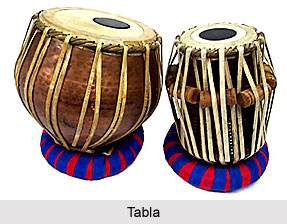 Drumming in Hindustani music is an intricate and highly cultivated art. In north India, the principal drumming tradition today is the Tabla tradition. Tabla strokes are spoken in syllables, generically called Bols. For one stroke there can be a variety of Bols and varying strokes for one Bol. The context decides the choice of syllable. Apart from the basic stroking patterns and the Tala, Hindustani drumming has numerous structural types which can be called as "compositions". Some of these "compositions" are Uthan, Mohara, Mukhra, Theka among others. The presence or absence of a Cadential Tihai is an important characteristic that distinguishes these types from each other.
Drumming in Hindustani music is an intricate and highly cultivated art. In north India, the principal drumming tradition today is the Tabla tradition. Tabla strokes are spoken in syllables, generically called Bols. For one stroke there can be a variety of Bols and varying strokes for one Bol. The context decides the choice of syllable. Apart from the basic stroking patterns and the Tala, Hindustani drumming has numerous structural types which can be called as "compositions". Some of these "compositions" are Uthan, Mohara, Mukhra, Theka among others. The presence or absence of a Cadential Tihai is an important characteristic that distinguishes these types from each other.
Tihai in Hindustani Drumming
One of the most common rhythmic formulas in the music is the Tihai. It is the melodic or rhythmic phrase which is repeated three times. It has such timing that the last stroke falls on count 1 of the next cycle, on a Cadential Sam. Usually Tihai is a concluding figure that brings closure to a section but can also be composed to be played as an independent composition. Most often the Tihai is calculated to end on the downbeat, but sometimes they are tailored to come to the beginning of the composition (since not all compositions start on Sam).
Technique of Tihai in Hindustani Music
Fashioning Tihais on the spur of the moment is the drummer`s skill and when the players sense from the melody that the soloist is about to create a cadence or when they are playing solo performances themselves. The Tabla player is always aware of precisely where he is in the Tala cycle and therefore how many counts are left in which to play a Tihai. They do the calculations swiftly in a flash of time and design Tihai that will end on count 1. A Tihai must create a drive to the cadence, no matter how short or long it is.
Types of Tabla Compositions in Hindustani Music
There are different types of Tabla compositions in Hindustani music which bestow a unique beauty to the renditions. Some of them end in Tihai whereas others do not.
Uthan
Uthan consists of a brief introduction that is entirely of closed (damped) strokes, followed by a section that introduces open (non-damped) strokes and increases the rhythmic density and ends in a Tihai. The remainder either is a traditional composition or is composed "in process" according to the concept of the structural type.
Mohara
A Mohara occurs at cadences and is usually a mini-structure. This brief composition ends in a Tihai. It is played at a very fast speed and generally consumes only the last 4 counts (or 8) of Tintal. Owing to its quick occurrence it is frequently inserted at cadences when the drummer is accompanying a melody-making soloist.
Mukhra
Mukhra is another Tabla structure that is similar to the Mohara but does not end in a Tihai. It is 4 (or 8) counts long (in case of Tintal). It creates a drive to the cadence, but it does this without a Tihai. Both Mohara and Mukhra can be traditional compositions, or they can be composed in process.
Theka
A Theka is associated with a particular Tala and is a one-cycle-long traditional composition. Thekas form the basic material used in accompanying certain types of performances. These are also used in learning to play a Tala.
Kayda
A Kayda is another composition which exploits the Tabla`s ability to contrast open and closed sounds. The genre of this composition if is theme-and-variations in which a given composition (the Kayda) is put through a series of regulated permutations. The variations are referred as Palta. Each successive Palta is more a variation of the preceding Palta than of the original theme and by the time thirty or forty variations have been created, the theme (in Western thinking) is no longer there. In Indian thinking, the theme is still there because the continuity is there.
Other Types of Tabla Compositions
Other types of compositions are distinguished by functions, as, for example, those used at cadences. Other types include Tukra, Chakradar Tukra, Rela, Paran and Peshkar that are used when the Tabla is played solo, whether at designated moments during an instrumental performance, or in a Tabla solo performance. They are distinguished by types of Bols used, type of variation involved, and even whether or not variation techniques are used at all. Hindustani Tabla drumming thus involves a rather complicated set of techniques and principles.




















